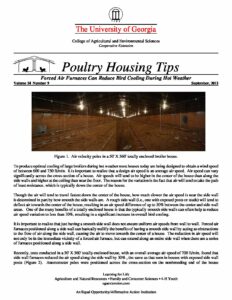To produce optimal cooling of large broilers during hot weather most houses today are being designed to obtain a wind speed of between 600 and 750 ft/min. It is important to realize that a design air speed is an average air speed. Air speed can vary significantly across the cross-section of a house. Air speeds will tend to be higher in the center of the house than along the side walls and higher at the ceiling than near the floor. The reason for the variation is the fact that air will tend t...o take the path of least resistance, which is typically down the center of the house.
Though the air will tend to travel fastest down the center of the house, how much slower the air speed is near the side wall is determined in part by how smooth the side walls are. A rough side wall (i.e., one with exposed posts or studs) will tend to deflect air towards the center of the house, resulting in an air speed difference of up to 30% between the center and side wall areas. One of the many benefits of a totally enclosed house is that the typically smooth side walls can often help to reduce air speed variation to less than 10%, resulting in a significant increase in overall bird cooling.
It is important to realize that just having a smooth side wall does not ensure uniform air speeds from wall to wall. Forced air furnaces positioned along a side wall can basically nullify the benefits of having a smooth side wall by acting as obstructions to the flow of air along the side wall, causing the air to move towards the center of a house. The reduction in air speed will not only be in the immediate vicinity of a forced air furnace, but can extend along an entire side wall when there are a series of furnaces positioned along a side wall.
Recently, tests conducted in a 50' X 560' totally enclosed house, with an overall average air speed of 700 ft/min, found that side wall furnaces reduced the air speed along the side wall by 30% , the same as that seen in houses with exposed side wall posts (Figure 2). Anemometer poles were positioned across the cross-section on the nonbrooding end of the house approximately 80' from the tunnel fan end wall (Figure 1). There were three equally spaced forced air furnaces on the nonbrooding end of the house, positioned two feet from the side wall and one foot above the floor. The anemometer poles were eight feet upstream of the furnace closest to the tunnel fan end wall, and 60' downstream of the center nonbrooding end forced air furnace.
The air speed five feet from the side walls with near the forced air furnaces was approximately 200 ft/min lower than from the side wall without the forced air furnaces. Though the greatest reduction in average air speed occurred near the side wall, the forced air furnaces negatively affected the air speed as far as 15' from the side wall (Figure 2).
A 200 ft/min reduction in average air velocity would likely result in a significant decrease cooling for roughly 10% of the birds on the nonbrooding end of the house during hot weather. In fact, research has indicated that a decreasing air speed from 700 to 500 ft/min could increase the effective temperature six degrees or more. The research is supported by the grower’s observations that during hot weather with market age birds, he tends to find more mortality along the side wall with the forced air furnaces......
Details
| Year | Volume | Number | Categories |
|---|---|---|---|
| 2012 | 24 | 9 |

